Shanxi Street Food: Mala Ban from Jinzhong
Lead-in: In northern China, a snack quietly steals the show—Shanxi’s Mala Ban. Less soupy than mala tang and more intense than a simple salad, this Jinzhong specialty is a dry, sauce-mixed bowl that delivers bold flavors and streetwise comfort. Whether you’re rushing by or seeking an authentic bite, Mala Ban reveals the true warmth and taste of Shanxi streets.
1.From Mala Tang to Mala Ban: A Flavorful “Less-Soup” Revolution
Mala Ban originated in Jinzhong, Shanxi, in the 1990s. Inspired by the Sichuan-Chongqing mala tang craze sweeping China, local vendors adapted the concept for northern palates and climate. They reduced the broth and introduced proprietary dry sauces, creating a concentrated, intensely flavored dish. The change kept the numbing-spicy (mala) character but made the snack quicker, less sweaty to eat, and more fitting for Shanxi life—so Mala Ban became Jinzhong’s local spin on mala street food.
2.A Shanxi Bowl: Ingredients and the Sauce that Steals the Show
Mala Ban’s freedom is part of its charm. Shops display a refrigerated counter of dozens of choices: potato slices, napa cabbage, spinach; bean products like tofu sheets and tofu; meat options such as beef balls and thinly sliced beef; and staples like wide rice noodles or instant noodles. Diners pick what they want, assembling a personalized bowl.
The true soul, however, is the sauce. Typical options include:
- Classic mala: a layered mix of Sichuan peppercorn for numbing, dried chili for heat, and various aromatics for complexity.
- Sweet-and-sour: adds sugar and vinegar to tame and balance the spice.
- Sour-and-spicy: brighter and more cleansing on the palate.
Each shop guards its sauce recipes closely—those secret blends are why customers return.

3.Tasting Shanxi: Texture and Flavor Experience
When your Mala Ban arrives, the aroma hits first: prickly Sichuan pepper, warming chili, nutty sesame, and sharp garlic. After mixing, every ingredient is coated in glossy sauce.
The mouthfeel is a playful mix: crunchy potato slices, bouncy beef balls, slippery wide noodles, and chewy tofu skin—together a texture symphony. Flavor-wise, the mala base provides an assertive backbone. Classic mala tingles from tongue to throat; sweet-and-sour soothes with a playful tang; sour-and-spicy is refreshing yet exciting. That contrast and intensity are why Mala Ban hooks so many, especially younger diners.

4.How to Eat Mala Ban Like a Local: Practical Tips
If it’s your first time, try these tips:
- Choose a busy shop: locals in line usually means authentic taste and good price. Near schools and commercial streets are reliable.
- Try the classic combo: potato, wide noodles, cabbage, tofu skin, and beef balls—safe and satisfying. If you’re adventurous, add items like tripe or duck blood for a more local experience.
- Spice level: tell the vendor “no spice” or “mild” if you can’t handle heat. Shanxi’s “mild” can still be stronger than other regions’ medium. Sweet-and-sour is a good option for spice-averse eaters.
- Best beverage: an iced Asian soda or sour plum drink (suanmeitang) cools and soothes the palate.
- Timing: Mala Ban works for lunch, dinner, or late-night snacks. Avoid eating it first thing in the morning on an empty stomach due to its strong flavors.
5.Make Mala Ban at Home: Simple Homemade Version
If you fall in love with Mala Ban while traveling, you can recreate a simple version at home.
Ingredients: your choice of vegetables, balls or sliced meats, wide rice noodles or instant noodles.
Sauce core: 2 tbsp peanut butter (or sesame paste), 1 tbsp light soy sauce, 1 tbsp vinegar, 1 tbsp sugar, 1 tbsp minced garlic, chili powder and ground Sichuan pepper to taste, 1 tbsp toasted white sesame, salt to taste.
Method: blanch or cook all chosen ingredients and drain them thoroughly—draining is essential for a dry mix. Combine sauce ingredients until smooth, then toss with the drained ingredients until evenly coated. Garnish with chopped scallions and crushed peanuts. It won’t exactly match a vendor’s secret mix, but it captures the spirit and satisfies cravings.

Conclusion and Call to Action:
Mala Ban may look simple, but it embodies Shanxi people’s culinary creativity: pragmatic, bold, and adaptable. From street stalls in Jinzhong to tables across China, this dry-spicy mixed bowl shows how local innovation reinvents tradition. When you’re in Shanxi and smell that familiar mala aroma, join the queue—order your bowl, tuck in, and let Mala Ban become one of your tastiest travel memories. After all, the best way to know a place is through its food.


